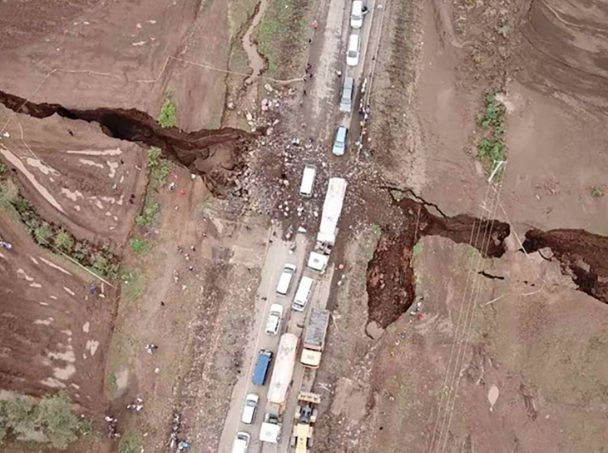Although the expected big split is not likely to happen in our lifetime, the impacts are showing. Ever since the volcanic eruption in 2005, Afar has transformed dramatically. The desert has fissures packed with molten rock that has cooled down.
Thanks to advanced satellite data, scientists can now see clear signs of this transition taking place. You see, as the tectonic plates peel apart, material from deep inside the Earth starts to move up to the surface and form oceanic crusts in the ridges.
This is a treat since most of these things happen in the sea, making researchers have a hard time observing it. But thanks to the fissure in the Afar desert, they can learn more about tectonic plate movements.
Birth of a new ocean: University of Bristol seismologist Dr. James Hammond has been working in Afar desert. He says that parts of the area are below sea level and the ocean is just blocked by a 20-meter block of land in Eritrea.
If the ocean manages to flood in the fissures, this will start to create a new ocean. The flooding will sink down and pull apart some parts of Ethiopia. They have estimated that Somalia and some parts of southern Ethiopia would drift off and become islands of the Indian Ocean.
Another crack in Kenya: With all of this happening in Ethiopia, media outlets started buzzing again when a large crack formation showed up in Kenyan Rift Valley in April 2018. Many reports have taken it as a confirmation that African continent is indeed splitting up into two pieces.
The appearance of the cracks was coincidental with occurrence of frequent earthquakes happening at the time. Plus, the cracks were located where a new tectonic plate boundary was forming. So naturally, people assumed that this case was the same as that in Ethiopia.
But upon investigation, researchers found that the cause of these huge cracks in the land was something else entirely. It turned out that the crack was not formed by movements of tectonic plates but by soil erosion beneath the surface.
The erosion was caused by heavy rains that had taken place in the region. The rainwater had washed away the deep layers of loose volcanic ash that happened to be deposited by previous volcanic eruptions in Kenya rift valley.
Remembering Pangea: This is not the first time continents are tearing apart. In fact, 300 million years ago, the continents and the oceans that we now know did not exist. A map back then would be a far cry from what we have now.
There was just this one huge land mass called Pangea and a huge global ocean called Panthalassa. Then, 100 million years later, Pangea started to divide, creating the continents that we know now. The division also transported the Panthalassa into separate oceans.
And now, it seems that the division of land mass will be happening again. In a few million years from now, the African continent will turn into a cluster of archipelagos surrounding a large piece of what would remain of the original continent.
The researchers find that we are extremely lucky to witness the birth of an ocean in our lifetime. Thanks to this phenomenon, researchers and scientists will be able to understand the natural hazards and the effects of earthquakes and volcanic eruptions better.
Global phenomenon: But did you know that Africa is not the only place that is in danger of splitting up in the future? It turns out that rifts and fissures are forming all over the globe. About 8,000-km from Ethiopia, Iceland is at risk of splitting up too.
Iceland is a small island country that can be found between Greenland and Norway. It is called the land of fire and ice because of its contrasting landscapes. It is home to several volcanoes.
Drifting plates: Iceland sits between the Eurasian and North American tectonic plates. These two plates are found to be drifting apart and when that happens, Iceland can be in danger. It is estimated that the country might split into three parts.
A fissure can be found in Þingvellir region – an area that has an active volcanic and tectonic environment. Several cracks can be found on the surface of the plain and new cracks are appearing as time passes.
The earth is indeed full of surprises. It makes one pause to think and wonder about the impact humans have in causing these geological changes. It is about time that we start taking better care of the planet so that future generations can still benefit from it.
The phenomenon happening in the Afar desert of Africa is considered to be the site of the very first continental breakup that would involve and impact modern human existence. Who would have thought that one of the driest and hottest deserts on Earth will be the birthplace of a new ocean?
By Pradeep Kumar
Arunachal Observer





























